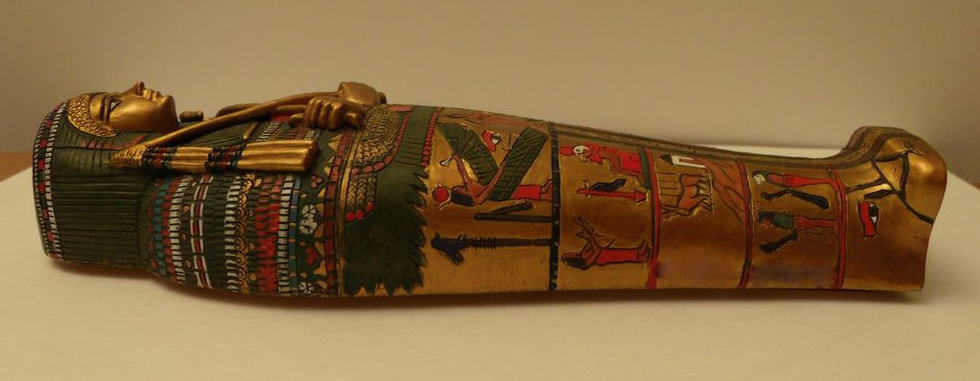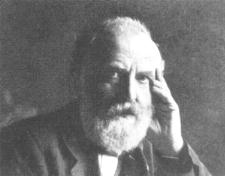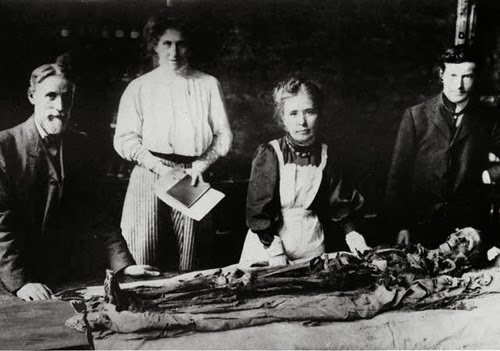

The decades since 1912 have seen the evolution of a strange
legend which has become inextricably bound to the story of the
"unsinkable" Titanic. Lately there has been a resurgence
of interest in the claim that a "cursed" Egyptian mummy case was
being shipped to America on board the Titanic and it was
that "curse of the Pharaohs" which caused the unsinkable White
Star liner to founder.
Two recent articles in the Titanic Commutator have done a
good job of acquainting readers with the basics of the
legend. (See Ed Kamuda's The Titanic Mummy Legend in
Vol 18, No. 2, and Grace Eckley's W.T. Stead, Natural and
Supernatural in Vol. 18, No. 3.)
As Grace Eckley correctly points out, the original tale actually
began with the discovery of a certain mummy case in Egypt in the
late 1860's. Following its acquisition by several Englishmen
(one of whom was Douglas Murray), the "cursed" mummy case is said
to have left a long trail of misfortune in its wake as a steady
procession of frightened owners relinquished their custody of the
ancient relic to others. The sarcophagus eventually found a
permanent home in the Second Egyptology Room of the British
Museum.
Like all good folktales, the story of the discovery and
subsequent adventures of the "cursed" mummy case has not remained
static; although the basic elements of the story endure, most
published re-tellings of the tale contain details unique to those
particular versions. (One good reason for this is that the
"standard" mummy story is apparently based on the careers of at
least two, and probably three, different containers.) Still,
the anecdote is an intriguing one that has undoubtedly raised
goosebumps on more than one superstitious reader during the last
hundred years.
How did the above tale of the British Museum's "haunted" mummy
case ever become associated with the Titanic disaster?
Originally the association was an innocent one. William T.
Stead, the well-known journalist and advocate of spiritualism, is
known to have displayed an interest in the British Museum's
"cursed" sarcophagus, and he was also one of those people who had
booked passage on the Titanic's maiden voyage.
During the evening of April 12, 1912, the third night out at sea,
several passengers in the ship's smoking room began to tell ghost
stories that inspired Stead to regale his fellow passengers with
the talk of the mummy case of doom in the British Museum. He
even told his listeners that the curse included the proviso that
anyone who verbally related the afflicted container's adventures
would soon meet with a dire end. (Frederic Seward, the only
member of Stead's audience to survive the Titanic's
sinking, later decided not to tempt fate -- he declined to repeat
the story for an interested New York reporter.

It would appear that the above incident was the original catalyst
behind the general public's association of a "cursed" Egyptian
mummy case with the loss of the Titanic and it didn't take
long before that train of thought had grown far beyond being a
simple mental connection between two subjects. Within
four years of the Titanic's sinking, stories had become
widespread that a "mummy of evil" inside the case had
actually been responsible for the great liner's loss.
An article by Marion Ryan in the August 27, 1916 issue of the Weekly
Dispatch mentions Sir Wallis Budge's emphatic statement that
there was no such "mummy of evil" in the British Museum and never
had been. Budge also denied the widespread rumors that
the museum had sold such an artifact to an American millionaire
who was transporting the item to America on board the Titanic.
He added:
The nucleus of all these wild and fantastic tales is this. We have the sarcophagus which once contained the mummy of a high priestess of Egypt who may or may not have committed evil deeds in her lifetime. In some strange way the traditions which gathered about two mummies brought to England by people not connected with the museum at all became attached to the sarcophagus of the high priestess.That information may well account for the evil reputation attributed to the British Museum's mummy case; even so, it is quite possible that previous custodians of that particular sarcophagus did indeed suffer the misfortunes enumerated by Grace Eckley. (Indeed, the September 30, 1916 issue of Light contains a letter by Miss E. Bates who said she was told substantially the same account of those misfortunes by Douglas Murray himself. The 1928 autobiography of the notable palmist Cheiro - William John Warner - also contains much the same information as recounted to the author during personal interviews with Murray.)
One of these mummies belonged to Mr, Ingram and was in the British Museum for a time on exhibition before it was sold by the owner to the late Lady Meux. There were traditions of an evil influence wielded by this mummy which led to disasters being brought down upon various people, but I have never heard them verified. The other mummy was brought to England by a wealthy Englishwoman. That mummy was never in the British Museum, but during the time it was in England there were stories of strange and terrible disasters said to have happened to those under its influence.
These tragedies occurred so often and so mysteriously that they seemed to go beyond the range of coincidence, and the owner of the mummy did not care to possess it any longer, so arrangements were made to take it back to Thebes and rebury it. These arrangements were carried out in due course, and the mummy of that high priestess or princess is disposed of for all time probably, but the stories of her influence for evil, which gradually leaked out, seem in some mysterious way to have attached themselves or been attached to the cover of the sarcophagus of the high priestess in the Museum.
